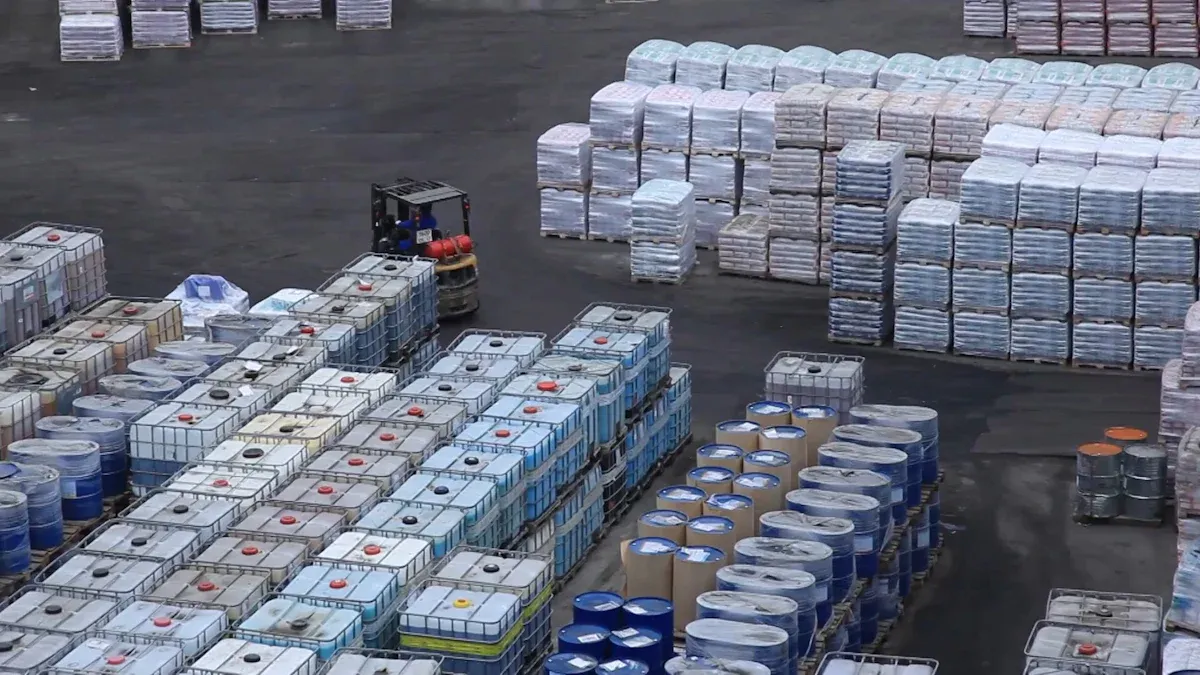Overcoming Holiday Logistics Challenges for Reliable Business Growth

Can a business grow if holiday logistics fail? Each year, companies face challenges like insufficient inventory, late shipping, and incorrect orders. These issues upset customers and lead to lost sales. A late delivery can damage trust and reduce profits. Many businesses now rely on reliable logistics systems with real-time inventory tracking. They also communicate with customers early to keep them satisfied. Reliable logistics help businesses avoid missed opportunities and secure repeat customers during busy seasons.
Key Takeaways
Good inventory management during holidays stops lost sales. It also keeps customers happy. Shipping delays make customers lose trust. Fast and reliable delivery is very important. Flexible staffing helps during busy holidays. Part-time and seasonal workers are useful. Real-time tracking and smart technology help orders stay correct. They also keep customers updated. Clear and simple return policies build trust. They make customers want to shop again. Planning early helps with holiday logistics. Good communication with suppliers also helps. Working with logistics partners helps avoid delays. Using data helps stop mistakes. After each holiday season, review your process. Improving it makes the business stronger.
Holiday Challenges

Inventory Issues
Handling inventory during the holidays is tricky. Many businesses have trouble keeping enough stock. The fourth quarter is very important for sales. It can make up 40% of yearly revenue. If inventory is not managed well, companies lose money and trust.
Stockouts
Stockouts mean popular products sell out too fast. This happens a lot during the holidays. Shoppers buy more and shop earlier. When stores run out of best-sellers, customers get upset. They might shop at other places. Lost sales add up fast. In 2021, missed sales from stockouts were about $1 trillion. Stockouts also make customers lose trust. People want to find what they need, especially during holidays. If they can’t, they may not return next year.
Tip: Real-time inventory management software can warn about low stock. Doing regular cycle counts and training workers helps stop stockouts.
Overstock
Overstocking is when businesses guess demand too high. Extra inventory uses up money and fills warehouses. Companies often sell extra items for less money. This lowers profits. Sometimes, unsold items get thrown away, especially if they spoil. Storing too much costs a lot and wastes products. Good inventory management means having enough, but not too much.
Overstock causes:
More money spent on storage, utilities, and workers.
Lower profits from selling items at a discount.
More waste, especially for things that expire.
Shipping Delays
Shipping delays are a big problem during holidays. Carriers get too many orders to handle. Online shopping makes delivery networks busy. About 70% of people had shipping delays in the last six months. Most delays happen during busy times. Labor shortages, bad weather, and supply chain problems cause delays. Ports and trucks also slow things down.
Shipping delays do more than annoy customers. They can hurt a brand’s reputation. Studies show 69% of shoppers will not come back if orders are late by more than two days. Late packages lead to bad reviews and refund requests. Customers often blame the brand, not the shipping company.
Labor Shortages
Labor shortages make holiday logistics harder. Many companies can’t hire or train enough workers. This puts more work on current staff. Workers get tired and make more mistakes. Orders take longer to fill, and errors go up. Store workers often do many jobs at once. It is hard to keep up with both in-store and online orders.
Note: Planning early and using flexible staffing helps with labor shortages. Part-time shifts, automation, and clear steps keep orders moving, even with fewer workers.
Returns Surge
Returns go up a lot after the holidays. Many people get gifts that do not fit or are not what they like. Some gifts arrive broken. Some shoppers buy many sizes or colors and send back what they do not want. This big wave of returns is hard for businesses.
The return rate is just over 16% most of the year. After the holidays, it goes up to about 18%.
In 2022, 17.9% of holiday items were sent back. That was $171 billion.
The National Retail Federation thinks returns will be 17% higher in winter 2024 than the yearly average.
About 57% of small and medium stores think they will get more returns this year than last year.
All returns in 2024 could reach $890 billion. That is almost 17% of all yearly sales.
Returns are not just lost sales. They cost extra money and slow things down. Businesses pay for shipping, storage, and more workers to handle returns. Each return can cost $20 to $30. This is worse for big or cheap items. Reverse logistics means sending, checking, restocking, or throwing away products. This takes time and space. Warehouses get full, and new stock moves in slower.
Tip: Automation helps a lot. Machines can check, sort, and store returns faster. This saves on worker costs. Using data helps managers see what is happening and change plans fast.
Returns make work harder for employees. They must handle new orders and returns at the same time. This can cause mistakes and slow things down. If returns are not managed well, customers get upset and profits go down.
Demand Fluctuations
Holiday demand goes up and down a lot. Many things can change how much people buy. Businesses must watch these changes to avoid running out or having too much stock.
Old sales numbers show clear patterns. For example, winter clothes sell more in cold months. Toys sell fast during holidays.
Market research and studies help spot when demand jumps. This happens when a new gadget gets popular.
Big changes in the economy also change how much people buy.
Sometimes, demand changes for no clear reason. A new trend or viral product can make sales jump.
Outside events, like tourist seasons or big games, can make more people buy things.
Smart businesses use forecasting models to find these patterns. They look at years of sales to see when sales go up or down. They also watch what people look at online and if they leave items in their carts. This helps them see when demand might change. Real-time data lets them react fast if something new happens.
Note: Analytics tools and machine learning help guess demand better. These tools help plan stock, target ads, and set prices that fit what customers want.
When companies know how demand changes, they can get ready. They avoid running out, stop having too much, and keep customers happy, even when holidays are busy.
Proactive Strategies

Early Planning
Planning early helps businesses do better during holidays. Companies that get ready months before have fewer problems. They look at last year’s sales and check if suppliers are reliable. They also test their systems before things get busy. This helps teams find and fix problems early.
Talking often with suppliers helps spot issues before they get big. Changing how the warehouse is set up and hiring early keeps things running well, even when orders go up.
Here are some real examples of how early planning helps:
A fashion store handled twice as many holiday orders with no delays. They used smart inventory tools and had many warehouses.
An electronics shop made their warehouse work better and shipped faster. This made customers 30% happier.
Starting sales early spreads out orders and helps sell more items. Testing technology before the holidays stops system crashes. These steps make businesses stronger and keep customers happy.
Forecasting
Forecasting helps companies guess what people will buy. They look at old sales, trends, and what people talk about online. Special software uses this information to guess which items will sell best. Predictive analytics and machine learning can make forecasts up to 82% more accurate.
Companies use inventory software to watch stock in real time. Automatic alerts warn when items are almost gone. Teams change orders based on forecasts and what suppliers say. Checking data often keeps it correct. Training workers on these tools helps everyone act fast.
Real-time data from websites, social media, and CRM systems shows what people want. This helps companies react quickly if things change.
Good forecasting stops stores from running out of popular items or having too much of slow sellers. Shelves stay full and customers are happy.
Inventory Management
Smart inventory management helps control busy holiday times. Companies use real-time tracking to watch stock everywhere. They look at old sales and trends to get ready for busy days. Automated systems move stock between stores to keep things balanced and cut down on discounts.
Here are some top ways to avoid running out or having too much:
Use predictive analytics to guess demand and order more automatically.
Order products only when needed to avoid extra stock.
Use different suppliers and sell many types of products to lower risk.
Set up alerts for low stock and sudden demand.
Plan budgets and use good financing to manage money.
Stores using real-time systems had 10-30% fewer out-of-stock problems. Bad inventory management can make customers 23% less happy during busy times.
Planning for after the holidays is important too. Sales and deals help clear out extra items. Looking at sales data helps make better plans for next year. These steps help keep customers coming back, even after the holidays.
Flexible Staffing
Flexible staffing helps businesses handle busy holidays with less stress. Many companies hire contract workers, part-time staff, and seasonal employees. This helps them meet high demand and keeps full-time workers from getting too tired.
Contract staffing brings in temporary workers with special skills. These workers fill in fast and help things run well.
Outsourcing busy times to contract staff saves time and money. Companies can focus on their main jobs while experts help with extra orders.
Experienced seasonal workers need less training. They work quickly and keep quality high.
Good planning mixes contract staff with full-time workers. This keeps teams strong and flexible.
Tiered staffing uses core teams, part-time, seasonal, and on-call workers. This lets companies add or cut staff as needed.
Volume-based scheduling matches staff numbers to order amounts. This stops slowdowns and keeps labor costs low.
Flex-up agreements let part-time staff work more hours when it’s busy. Companies do not have to train new people for short times.
Cross-department sharing moves workers where they are needed most. This uses everyone’s skills and keeps things moving.
Technology tools like scheduling software, mobile apps, and AI matching help managers act fast. Real-time analytics show where help is needed.
Employee-focused ideas, like self-scheduling and clear schedules, make workers happier. Workers feel important and stay longer.
Managing tiredness and asking about worker preferences cuts missed shifts by 30% and keeps 45% more workers. Quality problems drop by up to 35% during busy times.
Dynamic staffing lowers labor costs by 8-15% and makes service better. Fewer backorders mean happier customers.
Communication tools, like messages and visual boards, keep everyone updated. Shift fill rates go up by 70-80%.
Tip: Cross-training lets employees do many jobs. This helps when demand jumps and keeps things running smoothly.
Flexible staffing with technology and smart planning helps businesses stay strong. They can react fast, save money, and give great service even when orders go up.
Risk Planning

Risk planning gets businesses ready for holiday surprises. Companies use different ways to keep logistics working, even if things go wrong. They start by guessing demand using old data and market info. This helps them keep extra stock and avoid running out. Quality checks stop fake parts from getting in.
Working with trusted suppliers makes sure parts are real. Programs like Rand Certified™ help companies get the right products. Technology is important, too. Real-time tracking and visibility tools find problems early, so teams can fix them fast.
Using more than one supplier lowers the risk of problems. Clear talks with everyone keeps teams working together during busy times.
Companies also hire and train temporary staff to keep things running during busy seasons. Supply chain management software helps teams see what is happening and react fast. Backup plans for late trucks or bad weather keep orders moving. Watching things all the time helps businesses change plans quickly.
Scenario planning gets ready for things like port closures or storms. Each plan has a backup step.
Integrated ERP systems show the whole supply chain. Teams can change plans quickly.
Lean inventory methods, like just-in-time, fit busy holiday times.
Advanced modeling and AI forecasting help order the right amount.
Supplier ecosystem diversification builds a strong network.
Real-time tracking helps teams react fast to risks.
Financial risk management uses extra stock and other sources.
Note: Checking and updating risk plans often keeps businesses ready for anything. Being proactive helps companies keep promises, even when things go wrong.
Risk planning makes holiday logistics stronger. Companies that plan well can handle problems, keep customers happy, and grow every year.
Reliable Logistics Solutions

Real-Time Tracking
Real-time tracking has made holiday deliveries easier for companies. Customers want to know where their packages are all the time. They get updates on their phones or by email. This technology uses GPS, RFID, and barcode scanning to show where each order is. People worry less when they can see their package moving. They can also change delivery times or places if they need to.
Companies use smart route planning to handle more orders during holidays. Artificial intelligence helps drivers skip traffic and avoid being late. Exception management tools find problems early, so teams can fix them fast. These tools help keep everything working well.
Benefit Category | Explanation |
|---|---|
Improved Delivery Accuracy | GPS, RFID, and barcode scanning give real-time updates to plan routes and stop delays. |
Enhanced Customer Experience | Customers get real-time updates and ETAs, which lowers worry and makes them happier. |
Increased Operational Efficiency | Real-time data helps plan routes, save fuel, and make sure packages arrive on time. |
Increased First-Attempt Delivery Rates | Customers know when to be home, so fewer deliveries fail, which is very important during holidays. |
Customers trust brands that keep them updated. Real-time tracking makes people want to buy again. Tracking tools help companies stand out when it is busy.
Fast Shipping Options
Fast shipping is very important during the holidays. People want gifts to come on time, even if they order late. Companies give many shipping choices to help with this. FedEx and UPS offer overnight delivery, sometimes as early as 8:00am. USPS has Priority Mail Express, which is good for small packages and works on Saturdays. DHL is best for sending gifts to other countries.
Carrier | Strengths | Weaknesses | Best For |
|---|---|---|---|
USPS | Cheap rates, good for small packages | Can be slow during busy times | People who want to save money, small items |
FedEx | Very fast, reliable, great tracking | Costs more for big packages | Last-minute orders, fast delivery |
UPS | Reliable, good for big or heavy items | More expensive than USPS | Big packages, business shipping |
DHL | Great for shipping to other countries | Not many services in the US | Gifts going overseas |
Fast shipping usually costs more money. Overnight shipping can be three times more than regular shipping. Multi-carrier shipping software lets companies check prices and speeds. This helps them pick the best choice for each order. Good logistics means finding the right mix of price and speed, so customers are happy and businesses make money.
Companies with fast and flexible shipping get more repeat buyers. They also get better reviews during the holiday season.
Returns Management
Returns go up a lot after the holidays. Many people send back gifts that do not fit or are not what they wanted. Businesses need a simple and easy return process to keep customers happy. A good return policy should be clear and give extra time for holiday returns.
Companies use machines to handle returns quickly. Pre-made return labels and fast sorting help get items back in stock. Clear steps and updates make things easy for customers. Good logistics partners help sort and ship returns, even when there are a lot.
Here are some ways businesses handle lots of returns:
Make a clear return policy with more time for holiday gifts.
Use machines to make returns faster with pre-made labels.
Give customers easy steps and regular updates.
Sort returned items quickly and use many shipping partners.
Use strong boxes to stop damage.
Watch for fake returns with data and proof of purchase.
Ask for exchanges and feedback to keep customers coming back.
An easy return process builds trust. Customers remember brands that make returns simple. Good logistics help with every step, from sending orders to handling returns after the holidays.
Partner Collaboration
Working well with partners helps businesses deliver on time for the holidays. Companies team up with logistics partners to share tools and fix problems fast. They make strong partnerships so they can react quickly when more people order things. This teamwork makes Reliable Logistics work, even when there are lots of orders.
Some good ways to work with logistics partners are:
Share data and sales guesses early. This helps everyone get ready for busy days.
Use smart technology like artificial intelligence and data analytics. These tools help partners guess demand and plan delivery routes.
Make special logistics plans for each business. Custom plans keep deliveries on time and customers happy.
Work with more than one delivery company. This gives more choices and helps with last-mile delivery.
Set clear rules for service, timing, and backup plans. Everyone knows what to do if something goes wrong.
Check how things went after the holidays. Partners use this information to do better next year.
Good teamwork with partners means companies can handle more orders, stop delays, and keep customers coming back.
Companies also use Transportation Management Systems (TMS) to watch shipments and keep the supply chain clear. These systems help partners track orders, manage inventory, and find problems early. When everyone works together, Reliable Logistics is easier to reach.
Collaboration Strategy | Benefit |
|---|---|
Shared forecasting | Better planning and fewer surprises |
Advanced route optimization | Faster deliveries and lower costs |
Multiple delivery partners | More flexibility and coverage |
Clear service agreements | Fewer mistakes and missed deadlines |
Post-season review | Continuous improvement |
Customer Communication

Talking to customers is very important during the holidays. People want to know about their orders, especially when it gets busy. Companies talk to customers early to keep them updated and stop complaints.
They send updates about orders and tell customers if there might be delays. Customers get clear rules about returns and how to get help. This makes people less upset and builds trust. When customers know what is happening, they feel better about Reliable Logistics.
Proactive communication means:
Real-time tracking so customers can see their package.
Delay alerts if something goes wrong.
Special messages that make customers feel important.
Easy ways to get help, like live chat, email, or phone.
Well-trained workers who fix problems fast.
Companies that talk to customers well can turn bad times into good ones. Customers remember brands that keep them updated and help them quickly.
Clear and quick talking between logistics companies, businesses, and customers stops confusion. It helps fix problems before they get worse. During the holidays, this kind of Reliable Logistics support keeps customers happy and loyal.
Continuous Improvement
Post-Holiday Review
After the holidays, smart businesses look back at what happened. They collect data from every part of their logistics process. Teams check how fast orders shipped and how many were on time. They also count how many customers sent things back. Managers look at costs and how much inventory moved.
How many deliveries were on time
How many returns and how fast refunds happened
How much each shipment cost
How quickly inventory was sold
They compare labor costs for holiday orders to normal times. Training for seasonal workers is checked closely. Mistakes and fixes show where problems happened. Daily reports help find busy days and slow times. If orders got stuck, managers can see it. Department reports show how many orders, payroll, and inventory were handled.
Teams listen to customer feedback from surveys and social media. This helps them find problems and fix them before next year.
Process Optimization
Process optimization helps businesses improve every year. They use lean warehouse practices like 5S to cut waste. This makes work easier and faster. Labeling with barcode scanners or RFID tags helps track inventory. Picking orders gets faster with wave picking, zone picking, and special tools like pick-to-light or voice picking.
Lean warehouse practices help workers do more and make fewer mistakes.
Barcode and RFID systems make tracking and picking faster.
Better order picking means more orders and fewer errors.
Warehouse management systems help with inventory and worker planning.
Watching KPIs like pick rate helps teams see what to fix.
Cross-docking saves storage money and speeds up shipping.
Big companies see good results. Walmart saved 10% on inventory and had more products in stock. Johnson & Johnson used data to save 15% on shipping and delivered on time 99.8% of the time. DHL’s robots picked twice as fast and made 40% fewer mistakes. Amazon’s system made picking 30% faster. Maersk’s AI helped use containers 5-8% better.
Process improvements lower shipping and inventory costs. They help more orders arrive on time and make customers happier, especially during holidays.
Investing in Tech
Technology helps businesses stay ahead during busy times. Automation, AI, and better ways to talk to each other give the best results. Over half of logistics companies say too many messages slow them down. Automation makes jobs easier and keeps customers happy.
New tech like IoT sensors, drones, and robot ships promise faster deliveries. These tools help ship things quickly, make customers happy, and save money.
Key Features and Components | Cost Range (USD) | ROI Impact and Timeline | |
|---|---|---|---|
Warehouse Management Systems (WMS) | Real-time inventory tracking, smart restocking, better space use, easy integration | $250K-$750K | 30-50% better order speed; pays off in 18-24 months |
Micro-Warehousing with IoT Sensors | Small, flexible design, city locations, lots of storage, sensor networks | $250K-$750K | Big efficiency gains; pays off in 18-24 months |
Machine Learning Forecasting Models | Neural networks, time-series analysis, uses outside data | Needs strong computers | Makes demand guesses better, stops stockouts |
Dynamic Routing Optimization | AI and quantum computing, real-time data, predicts delivery times | N/A | Cuts delivery time 35-55%, saves 25-40% on costs |
Automated Picking & Robotics | Automated storage, robot picking, barcode/RFID tracking | Part of WMS and automation | Faster, more accurate picking, saves on labor |
Integrated Logistics Intelligence | ERP integration, cloud systems, API microservices, cybersecurity | $750K-$3.5M to start | Pays off in 24-48 months; better business decisions |
Investing in tech helps businesses handle more orders, ship faster, and keep customers coming back every holiday season.
Learning from Disruptions
Every holiday season brings new problems for businesses. Sometimes, snowstorms slow down deliveries. Other times, too many orders surprise everyone. Smart companies do more than just react. They learn from these disruptions and get better each year.
How do they turn problems into progress? Here are ways businesses improve logistics after holiday challenges:
They study the data. Teams check what went wrong and what worked well. Machine learning and data-driven forecasting help spot sales and shipping patterns. This helps them guess demand better next time. Fewer stockouts and less overstock make customers happier.
They expand their supplier list. Using only one supplier can cause trouble if there are delays. Working with more suppliers keeps companies flexible. If one cannot deliver, another can help.
They train their teams for anything. Cross-training full-time staff lets workers switch jobs when needed. Some companies use gig workers during busy times. This fills gaps fast when there are labor shortages.
They rethink their warehouses. Local and scalable warehouses move products closer to customers. Shorter travel means faster deliveries, even when roads are busy.
They keep customers in the loop. Real-time tracking and automatic updates show shoppers where their orders are. Honest updates build trust, even if there is a delay.
They upgrade their tech. Cloud-based systems help websites handle lots of shoppers. No one wants a website crash during a big sale.
They adjust prices quickly. Dynamic pricing lets companies change prices when demand goes up or down. This keeps them competitive and helps manage inventory.
Tip: After each holiday season, teams should meet and talk about what happened. They can ask, “What slowed us down?” and “What helped us succeed?” Honest feedback helps make better plans for next year.
Learning from disruptions is not just about fixing mistakes. It is about building a system that can handle anything. Companies that review, adapt, and improve after each holiday rush become more reliable. They keep customers happy and grow stronger every season.
Getting ready early, using smart technology, and having Reliable Logistics help companies do well during the holidays. Businesses that use real-time tracking, automation, and good forecasting have fewer stockouts and deliver faster. Customers trust brands that keep their word and make returns simple. When teams look back and get better each year, they earn loyal customers and become stronger. Now is a good time to prepare, try new tools, and make each holiday season even better.
FAQ
What is the biggest holiday logistics challenge for businesses?
Most companies have trouble with shipping delays. Delivery companies get too busy, so packages come late. Customers want their gifts to arrive on time. Businesses need good logistics plans to keep orders moving quickly.
How can a business avoid running out of stock during holidays?
They use real-time inventory tracking and smart forecasting. Teams look at sales data and order more of popular items. Regular cycle counts help find problems early.
Tip: Use analytics tools to guess demand and keep shelves full.
Why do returns increase after the holidays?
People get gifts that do not fit or match their style. Many shoppers buy extra sizes and send back what they do not want. Easy return policies make people feel safe to shop more.
What technology helps with holiday logistics?
Tech Tool | Benefit |
|---|---|
Real-time tracking | Shows where packages are |
Automation | Makes picking orders faster |
AI forecasting | Helps guess what people will buy |
These tools help companies deliver faster and make fewer mistakes.
How do flexible staffing plans help during busy seasons?
Managers hire seasonal workers and use part-time staff. Cross-training lets employees do different jobs when needed. This keeps orders moving and helps workers not get too tired.
What should a business do after the holiday rush?
Teams look at what worked and what did not. They check data, listen to customer feedback, and fix weak spots. This helps them get ready for next year.
Note: Honest team meetings help make better plans and stronger logistics.
How can companies keep customers happy if there are delays?
They send updates about orders and explain problems. Friendly messages and quick help build trust. Customers stay loyal when companies talk clearly.

TangBuy: A Smarter Way to Dropship in 2025
If you're looking to stay competitive with dropshipping in 2025, speed and trend-awareness are key. TangBuy helps you stay ahead with real-time product trends, fast fulfilment, and factory-direct sourcing. With over 1 million ready-to-ship items, 24-hour order processing, and seamless Shopify integration, TangBuy makes it easier to test, scale, and succeed in today's fast-moving eCommerce landscape.
See Also
Effective Strategies To Attract Customers To Your Online Shop
Top Trending Birthday Gift Ideas For Online Sellers In 2025
Complete Stepwise Plan To Start Dropshipping Business In 2025

